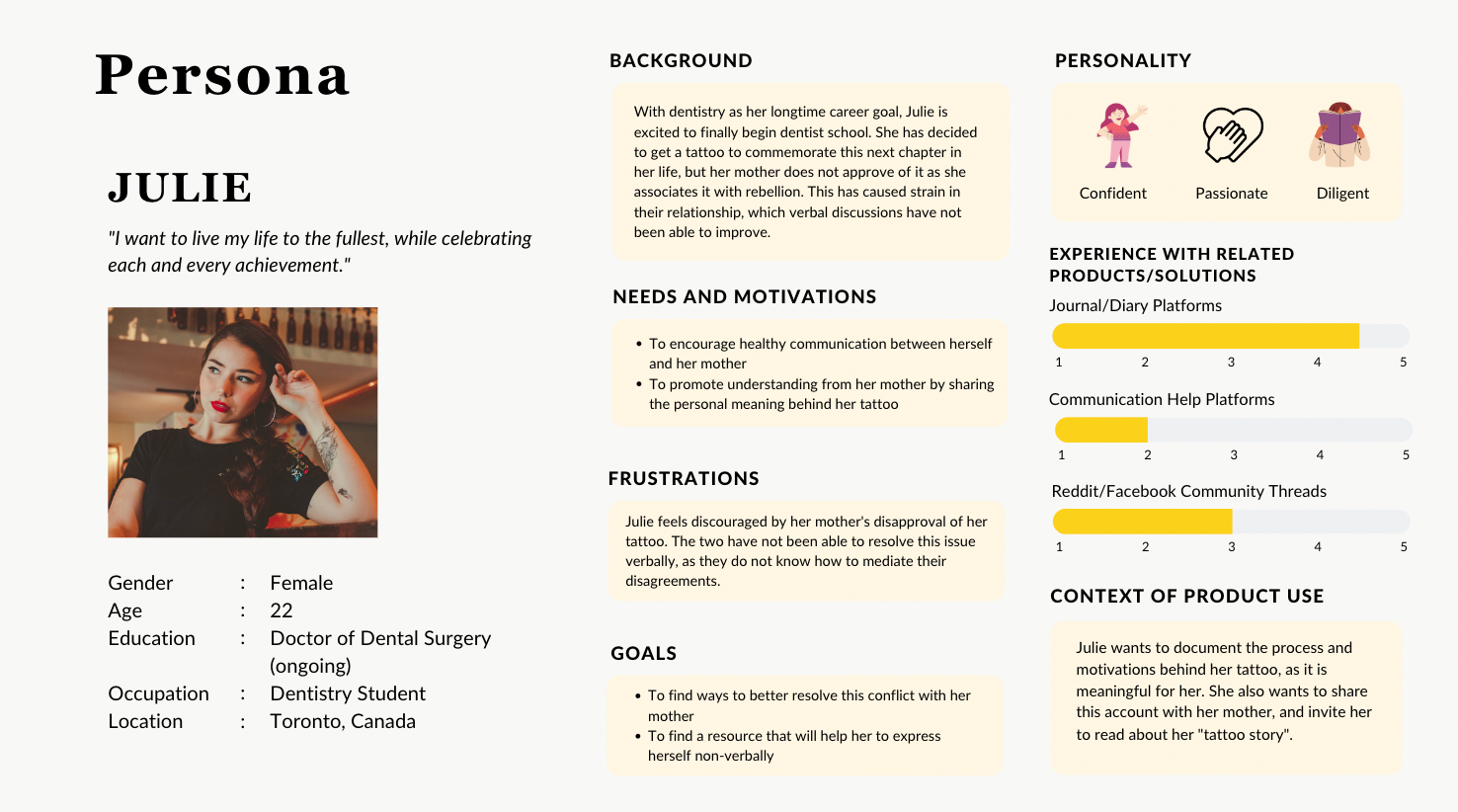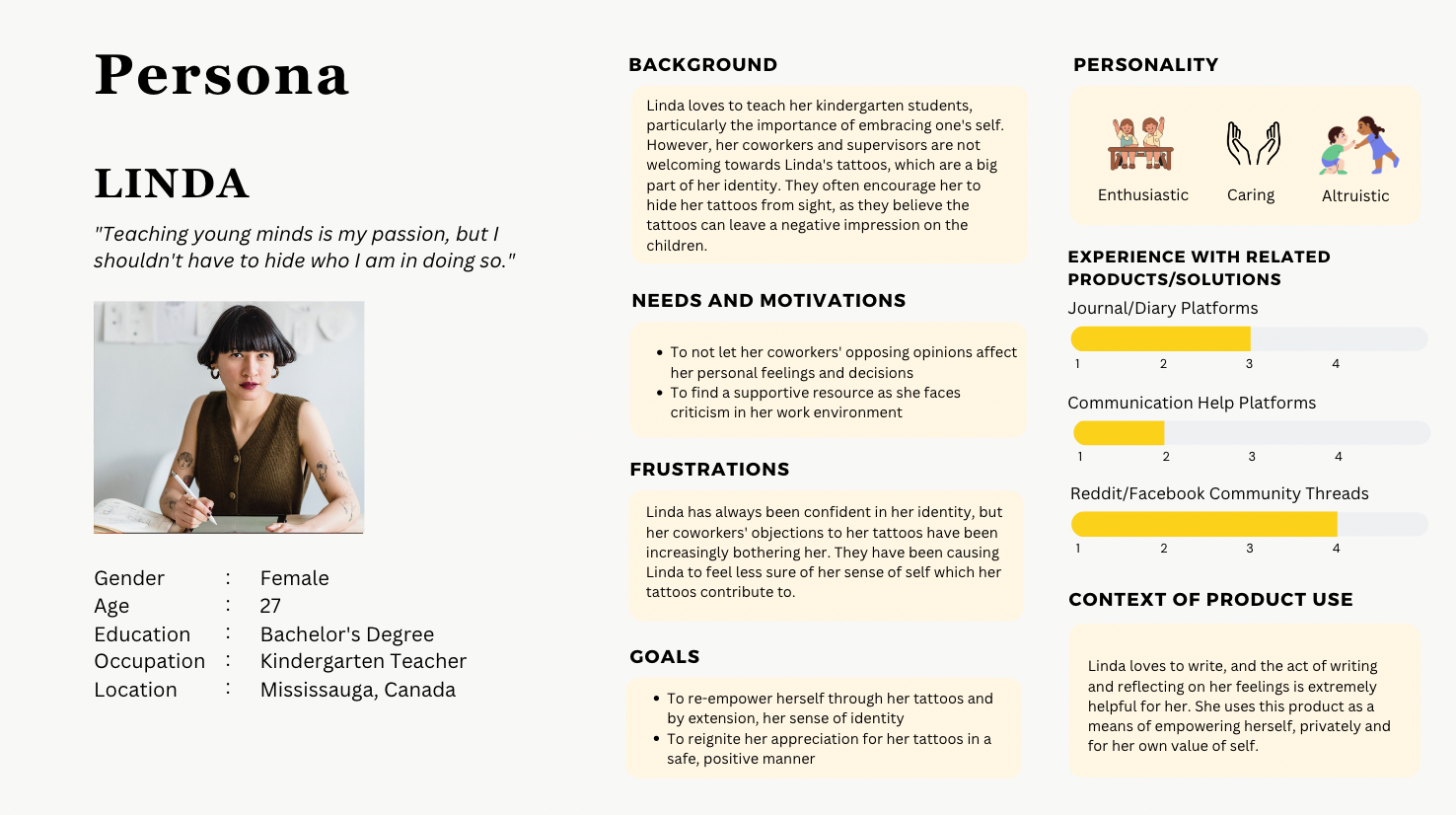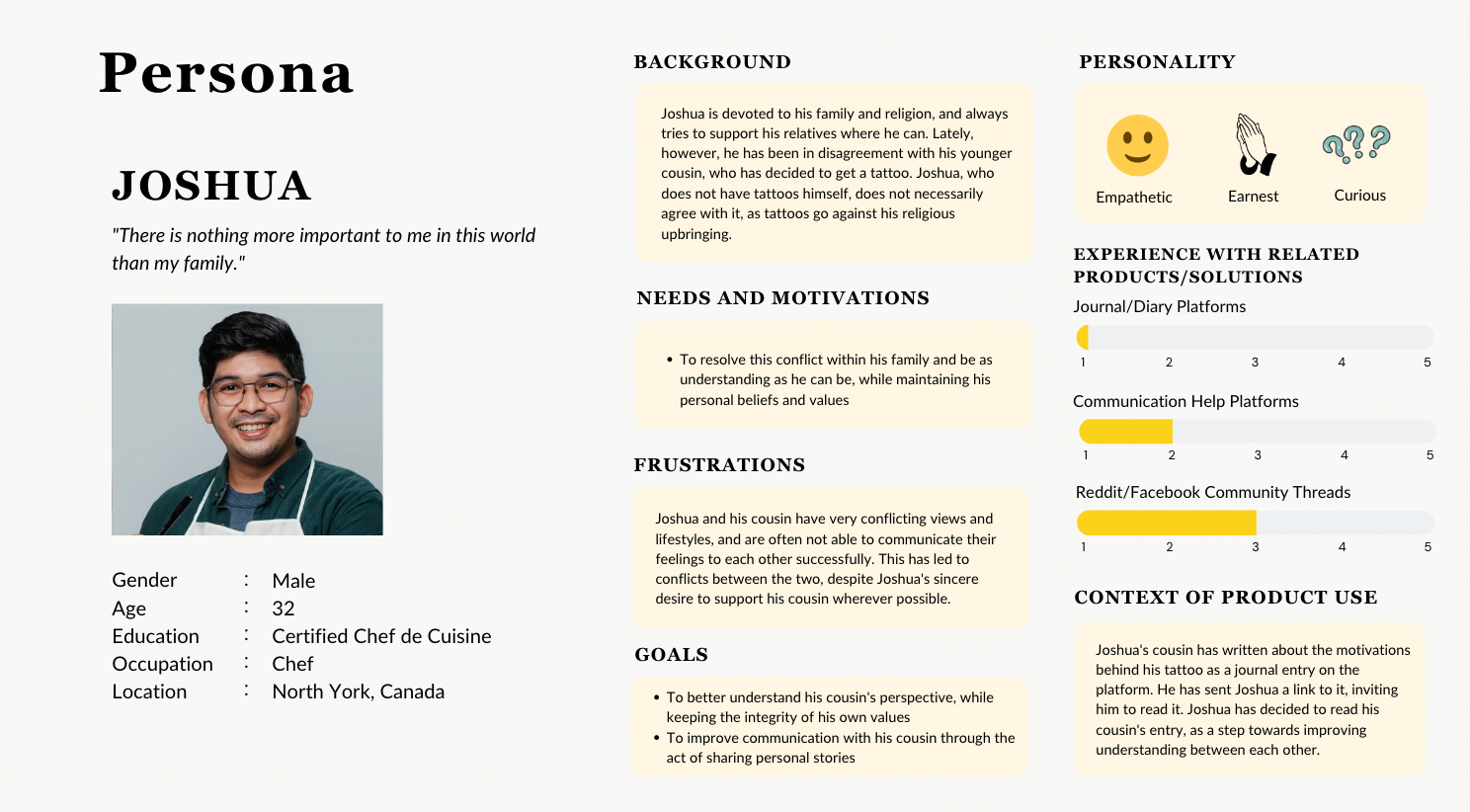Table of Contents:
01. Overview
02. Ideation
03. Research
04. Design
05. Conclusion
06. References
Scroll down to begin reading this story.
01. Overview
My Tattoo Story is a journaling platform that uses expressive writing to combat tattoo stigma. Users can freely write about their feelings and experiences regarding their tattoos and any discrimination they may have faced, while supporting one another in a like-minded community. I designed this product to be a storytelling and sharing platform, while incorporating aspects of both private journaling and social media.
Tools:
Miro
Adobe XD
Adobe Photoshop
My Role:
UX research
UX/UI design
Content strategy
Project management
Timeline:
Overall: 4 months
Discovery and research: 1 month
Design and testing: 3 months
Collaborators:
2 UX designers
1 content strategist
02. Ideation
Tattoos have always held a special place in my heart. I have a few which carry significant personal meaning, as do my sister, my close friends, and many others around me. Tattoos are beautiful and symbolic, yet are still shunned by a large portion of society. Tattoo discrimination can be a difficult topic for many people, but there is a lack of resources that can help those who are facing this situation.
That is why I wanted to focus this project on tattoos.
The Problem
While tattoos have become more accepted in today’s society, they still carry the stigma of criminalization and rebellion. This can be detrimental to the relationships between the people who have them and their loved ones who disapprove of them. This in turn can lead to the following 2 issues:
1) Communication difficulties between the 2 conflicting parties.
2) Difficulty in accepting one's own tattoos, as tattoos are often connected with a person's sense of identity.
I realized that there was a critical issue in people needing to express their feelings in a healthy manner, and gain community support regarding tattoo stigma.
The Goal
I wanted to give people a way to feel empowered about their tattoos, and create a safe space where they could find support and share stories with other like-minded members of a community.
03. Research
In this stage, I needed to learn about who my target users were, what their motivations and pain points were, and which framework would best suit the project's goal. I decided to use a combination of methods to gather the needed data. This consisted of surveys, an interview, and good ol' fashioned Internet research.
I already had a framework in mind that I wanted to use for my product—before moving forward with anything else, I needed to ensure that it was a solid idea.
Expressive Writing: a Tool for Communication
Many studies show that expressive writing is a popular, effective way of managing emotional well-being, including for feelings such as anxiety and stress (Siegel-Acevedo, 2021). I wanted to use this as an alternative method of communication to verbal conversations, and harness it as a resource for people who felt helpless against tattoo stigma.
Click on the image to zoom in.
Concept Validation and User Surveys: Key Findings
I conducted 2 surveys for this project: firstly, a concept validation survey that would determine if my idea had any merit to it. For this, I surveyed 15 people anonymously through Google Forms. Of these 15 participants, 8 had tattoos and 7 did not have any. Of the 7 participants who did not have tattoos, 5 expressed a positive opinion of tattoos, while the remaining 2 did not express their opinions of tattoos.
After analyzing all 15 responses, I found that 60% (9/15) participants thought that the problem was applicable and worth solving, while 26.7% (4/15) participants thought that the problem was not quite definite (13.3% [2/15] participants were not entirely convinced that it was a real problem). When asked about how they were currently solving the problem, the participants responded that they were either hiding their tattoos and managing their discomfort, or projecting a positive mindset regarding positive body image and tattoos.
Overall, participants expressed appreciation for my proposed product, and believed it to be a great way to promote tattoo positivity, share personal tattoo stories, and open positive conversations with people who do not approve of tattoos.
Next, I surveyed 21 people through Google Forms to learn more about target user behaviours, motivations, and furstrations. While their answers were also recorded anonymously, I pre-screened the participants as potential users who were interested in using this product.
Initially, I had envisioned that users would want a product that focused on a private writing experience, similar to writing in a personal diary. However, the majority of participants were interested in the "Reading other users' journal stories" feature. This was a pivotal point in my research: here was the moment when I realized that potential users were more likely to use my product for the story sharing aspect, and not the writing.
Concept Validation Interview: a Deeper Insight
While the Google Survey provided me with great feedback, I also wanted to hear directly from a potential user, to hear about their experience with tattoo discrimination on a more personal level. I conducted a 30 minute Zoom interview with a participant who provided me with detailed insight into their experiences and user pain points. I also asked questions about how they would use my product. The participant responded that they would likely engage with a photo album feature the most, indicating that visual elements were a key component to the user experience.
With this information on potential users, I was able to determine my target user groups:
Primary Target User Group
People who have tattoos and are experiencing social discrimination/disapproval from those who are not accepting of tattoos (for example, family members or friends). They may also lack complete acceptance of their own tattoos and self due to this social disapproval. They are envisioned to be predominantly young adults, such as those between the ages of 18 to 30. This group has the independence to receive tattoos without external supervision, but is also likely to still be influenced or affected by the opinions of others (i.e., friends and family).
Secondary Target User Group
People who do not have tattoos and do not approve of them, but are invited by the main users to read and engage with their story on the platform. They would likely not take initiative to first use this product, due to their opposing perspective (they would need to be invited by a user from the first group to engage in this product). As such, our product and core functions will be tailored towards the primary user group.
Market Research: the Competitors
After completing my user research, I shifted my focus to the current market, to assess existing competitors and their characteristics. I was unable to find any direct competitors, however, and could only examine similar ones. I identified indirect competitors to be digital journaling apps such as Waffle, relationship communication help platforms such as Talk2You, and discussion threads on social media platforms such as this Reddit thread.
While each of these products addressed a different problem, they pointed to 2 elements that were critical in keeping users engaged with a product:
1) Interactive, customized features such as daily writing and discussion prompts.
2) Interactions with other users on the platform, such as sharing or commenting on posts.
Now that I had the information that I needed, it was time to move onto the design.
04. Design
After synthesizing all of the research I had gathered, I imagined and reimagined a concept for my digital product: My Tattoo Story. This product would offer a story-documenting and sharing platform, with the goal of reducing tattoo stigma while promoting positive communication and empathy between people with tattoos, and their loved ones who are not so accepting of them. Much like a journal or expressive writing experience, it would allow users to document the journey, process, meaning, and photos of their tattoo(s).
The Site Map
In order to determine the information layout for My Tattoo Story, I created this site map for my product. I wanted to keep it simple, with only core actions and pages acting as the subheadings (“About”, “Account”, “Journal”, “Community”, and “Resources”).
Click on the image to zoom in.
The Personas
Based on my user research, I created 3 personas to represent my primary and secondary user groups. These personas were critical in getting a deeper understanding of the target users' motivations and potential interactions with my product. It was also helpful in designing the visual aspects of the platform.
Click on each image for a closer read.



The Prototype and Final Documentation
Using Adobe XD, I built a high fidelity prototype of My Tattoo Story, following the journey of the first persona (Julie). Here, my goal was to create the experience of a private writing session while being immersed in a digital community.
The complete interactive prototype can be found below, or at the following link: My Tattoo Story Prototype.
The complete documentation of this project (including the UX process, project management, and post-launch analytics components) can be found at the following link: My Tattoo Story UX Report.
05. Conclusion
With its lack of direct competitors, My Tattoo Story is a product for a specific user group who most likely has not had their user needs met in this way. While similar products exist on the market, my product is a one-of-a-kind solution that truly allows this user group to feel that their problems are acknowledged, and their voices are heard. My Tattoo Story is a platform which empowers these users, and provides them with the support that they need.
06. References
Siegel-Acevedo, D. (2021, July 1). Writing Can Help Us Heal from Trauma. Harvard Business Review. Retrieved April 5, 2023, from https://hbr.org/2021/07/writing-can-help-us-heal-from-trauma.
